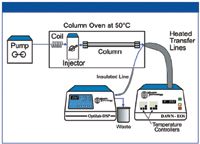Agarose-Heated Transfer Lines
The Application Notebook
Agarose is a polysaccharide produced from seaweed that forms a gel at room temperature. The characteristics of agarose gels depend on the agarose concentration, solvent, weight-average molar mass, and molar mass distribution.
Agarose is a polysaccharide produced from seaweed that forms a gel at room temperature. The characteristics of agarose gels depend on the agarose concentration, solvent, weight-average molar mass, and molar mass distribution. Powdered agarose, or agarose gel, needs to be heated in order to dissolve properly. Reheating a sample as well as other processing steps can change the agarose gel characteristics. This note describes the characterization of agarose by size-exclusion chromatography (SEC) and multi-angle light scattering (MALS) at an elevated temperature.
The agarose sample was dissolved by boiling for 10 s and then storing the solution at 50 °C. A second sample was dissolved, allowed to gel at 25 °C, then reheated to dissolution and maintained at 50 °C prior to analysis. All components of the SEC-MALS system were heated, operating at 50 °C. The solvent was heated to 50 °C by a coiled tube in the column oven and the injector and column were also housed in an oven. The tubing between the DAWN EOS and oven employed WTC's heated transfer lines. The flow cells of the MALS detector and the Optilab DRI detector were temperature-controlled at 50 °C as well. A schematic is shown in Figure 1.

Figure 1: HPLC system with MALS and DRI detectors at 50 °C. The heated lines prevent the agarose from gelling as it is analyzed.
The results for the fresh and reheated samples are overlaid in a cumulative distribution plot in Figure 2. It is clear from the graph that cooling and reheating degrades the sample. The molar mass results for the two freshly prepared samples overlay well, whereas the molar mass of the reheated agarose sample has decreased. This establishes a clear explanation for the differences in the performance of products from freshly prepared versus reheated agarose samples.

Figure 2: Cumulative molar mass plot of two agarose samples. Reheating of the sample results in a decrease of the molar mass.
This note shows that reliable results can be obtained even for delicate samples such as agarose. The thermostatic control options of the DAWN, coupled with its heated transfer lines, prove extremely useful in applications where sample solubility is required at elevated temperatures.
Wyatt Technology Corporation
6300 Hollister Avenue, Santa Barbara, CA 93117
tel. (805) 681-9009; fax (805) 681-0123
E-mail: info@wyatt.com; Website: www.wyatt.com

Follow the Data to Grow: Why a Scientific Data Platform is Essential
October 28th 2024Innovation is the engine that powers a company’s growth and product development, and for enterprises with R&D laboratories, those lab environments are the greatest source of this innovation. In this white paper, learn how a platform approach to scientific data management, including semantic search, advanced analytics, and lab automation, leads to better enterprise decisions at the executive level, optimized lab performance, more discoveries, and stronger product pipelines.
















